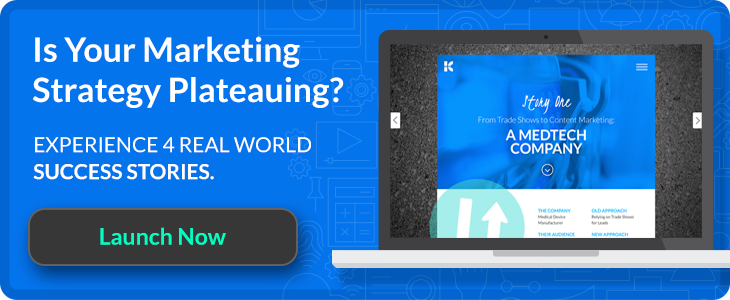
4 Solid Steps to a Modern Digital Marketing Strategy

 Being described as “classic” can be an honor: A classic album, a classic car, a classic film.
Being described as “classic” can be an honor: A classic album, a classic car, a classic film.
But if your approach to digital marketing is referred to as “classic,” it’s a big red flashing neon sign telling you it’s time for a change.
Unfortunately, if you Google “digital marketing strategies” you’ll get nearly 10 million results. And that’s just pages with that exact phrase in the title. To keep you from going down the Google rabbit hole, we put together a list of four straightforward techniques you can use to get your digital marketing where it needs to be.
But before we get started on how to modernize your digital marketing strategy, let’s talk about what makes a strategy outdated. If you’re utilizing any of the approaches below, stop. Now.
- Concentrating on low-value metrics, such as impressions and clicks. Impressions and clicks let you know whether or not your marketing is actually being seen but not the actual efficacy of your campaigns. Don’t miss the forest for the trees.
- Placing too much emphasis on the number of keywords in your content. Yes, you need to include keywords in your content, but Google is much more concerned with the user experience (UX) and relevancy of the content and less with how many times your website says “project management.”
- Relying on your gut. Your previous experience is certainly valuable, but making decisions about your digital marketing strategy based solely on what’s worked in the past is a bad idea. Using objective data to guide your strategy will yield better results.
- Focusing on your brand, not your audience. You (obviously) want buyers to know who you are but you shouldn’t plaster your brand name all over everything. Your content should be more educational and less promotional, especially when targeting buyers in the Awareness or Consideration stages of the buyer’s journey.
Ready to take your marketing from a Model T to a Tesla? Read on to discover how to build a modern digital marketing strategy.
1. Focus on the Right Methods and the Right KPIs
Wading through a sea of the latest tactics and methodologies is exhausting, and digital marketers can only do so many things so well. To keep yourself from drowning, reach for your marketing life raft: data.

Data keeps us from wasting time on strategies that aren’t producing results. So rather than pointlessly spinning your wheels and trying every new trend, think about what your brand’s key performance indicators (KPIs) should be. Defining your KPIs must be the first step as you refresh your strategy. If you don’t know what success looks like, you have no way of knowing whether or not a strategy is working.
While your list of KPIs will likely include the core metrics of impressions, clicks and conversions, you can’t stop there. Go beyond these basic calculations and think about the number of:
- Marketing Qualified Leads (MQLs) — Prospects who have indicated they have an active interest in the company
- Sales Qualified Leads (SQLs) — Prospects who have demonstrated a higher level of intent to become customers and are ready to be contacted by a sales rep directly
- Sales Accepted Leads (SALs) — Prospects proven to be qualified buyers worthy of pursuit
These metrics are a better measurement of the progress of your demand generation and lead generation campaigns. Analyzing this data will help you determine which digital marketing strategy is best for your unique brand, even if it isn’t the latest and greatest approach. And don’t be afraid to test different methods—just keep a close eye on those campaigns.
2. Build (and Maintain) a User-Friendly Digital Presence
Redesigning a website is not a simple process. It usually takes several months and requires the coordination of multiple departments across the organization—specifically, sales, marketing, design and development—as well as the investment of considerable time and resources.
But an outdated or poorly designed website can have a big impact on a brand’s success. Take a look at these stats:
- Nearly 40 percent of people will stop engaging with a site if the layout is unattractive
- A single second of added page load time can lead to a 27 percent lower conversion rate
- Half of the respondents in KoMarketing’s survey say poor navigation or design reduces a brand’s credibility
Your website must provide a positive UX, and a deciding factor in the UX is how easy it is for visitors to find what they’re looking for, such as details about your product or service and contact information for the company. From the moment they hit your site, visitors should be confident they’re in the right place and your brand has the solution they’re looking for.
Since digital real estate is limited, make sure everything on your site is useful—you have no room for fluff. Extraneous content will act as a barrier between buyers and what you want them to do: convert. Calls-to-action (CTAs) on your site should be clear, concise and conspicuous. Again, your goal is to make it as easy as possible for prospects to become leads.
In addition to decreasing the distance between point A (arrival on site) and point B (conversion), the steps along the way should be visually consistent. Every element of your site, from the logo in the header to the font in the footer to the background on least-visited internal page, should reflect your brand identity.
Pro Tip: Always keep search engine optimization (SEO) best practices in mind as you design your site. Don’t let your beautiful site end up at the bottom of search engine results because you didn’t consider site speed, mobile-friendliness, metadata, keywords or your linking strategy.
3. Use Marketing Attribution to Guide Your Process
Attribution models will help you understand the true performance of each channel and determine where time and resources should be invested. Marketing attribution is the process of identifying the individual interactions a prospect has with your brand throughout the buyer’s journey and then assigning credit to these interactions. It allows you to gain full visibility into how much each touchpoint influenced the buyer’s decision.
For example …
Your brand is using search engine marketing (SEM), display advertising and social media campaigns to promote an upcoming webinar. A prospect is first served an ad on the search engine results page, which he clicks. When he gets to the landing page, he decides to postpone registering for the webinar for the time being.
A few days later while the prospect is reading related content on the Google Display Network, he sees a retargeting ad reminding him about the webinar. Though he doesn’t click the banner, it puts your brand back on his radar. The following week, the prospect is served a “Last Chance to Register!” Facebook ad. He clicks on the post and signs up for the webinar.
Without attribution, you would most likely single out the Facebook ad as being the most effective. But in reality, it was a combination of the Facebook ad, SEM and retargeting that led to the conversion. And if this scenario (or a similar one) occurred repeatedly, you may reallocate budget away from your SEM campaigns and into your social media advertising, unintentionally hurting performance.
By using a marketing attribution model, you can see how each marketing channel interacts with the others, allowing you to better calculate ROI and make confident, data-driven assessments about the value of every channel. Following that first conversion event, you can continue to track the behavior of your audience and use the data you gather to see which types of campaigns are most effective at each stage of the buyer’s journey.
Pro Tip: HubSpot’s attribution reports help you analyze the conversion path to see what contributed to someone converting. Learn how to create one here.
4. Harness the Power of Inbound
Though you may have already incorporated some aspects of inbound marketing into your overall digital marketing strategy, are you getting the most out of it?

If you truly want to take full advantage of inbound, you should:
- Offer a variety of content. While you shouldn’t turn your back on blogs, eBooks and infographics, consider creating podcasts, videos or interactive content like an ROI calculator. Different segments of your audience will respond better to different types of content. Providing a mixture of content helps you stand out from your competition.
- Have something for everyone. Prospects just beginning their search aren’t interested in a buyer’s guide, and prospects who are ready to talk partnership probably don’t want an infographic about industry trends. Provide content for visitors in all stages of the buyer’s journey.
- Curate your content. Yes, it’s important to have an array of helpful, relevant content, but quantity should never outweigh quality. Buyers won’t consume your content simply because it’s there—it needs to be something that speaks to their unique needs at the appropriate time.
- Be selective about distribution channels. Every day there are new avenues for you to serve buyers content, but that doesn’t mean you need to be everywhere at once. You need to be where your target prospects are and give them the content that’s appropriate to their stage in the funnel. Most importantly, you should be helping them along their journey—not interrupting it.
- Repurpose your content. Don’t be afraid to repurpose your existing content into other pieces. For example, turn the transcript from a podcast into a blog post. Or take a chapter from an eBook and create an infographic. Ungated content can be used to promote the more comprehensive gated content. In other words, you can leverage demand generation to drive lead generation.
If you want your digital marketing to have the cachet of Casablanca but the gross revenue of Avatar (although that’s quite the lofty goal), you’ll need to make data-driven decisions based on your specific marketing goals and your audience’s specific objectives. By following the steps above, you’ll find it easier to build more effective, more powerful digital campaigns.
Special thanks to Reed Gusmus, Director of Marketing of QASymphony, for his valuable insight on this topic.




